Instantly recognizable by their colorful feathers, peafowl is generally widespread around the world and are even revered as symbols of power and wealth. However, there are rare breeds that need conservation as they continue to be threatened by habitat loss and hunting.
The rare peafowl breeds are the Bornean Peacock Pheasant, Congo Peafowl, Green Peacock, Wild Palawan Peacock, Great Argus Pheasant, Hainan Peacock Pheasant, Asia Peacock, and Grey Peacock Pheasant—a total of eight birds!
This article discusses everything you need to know about these rare peafowl breeds, their appearance, origins, distinctive characteristics, and other relevant information. Read further for more!
Rare Peafowl Breeds
Bornean Peacock Pheasant
This species is the rarest and least known of all birds in its family. The Bornean Peacock Pheasant is a highly elusive bird found in Borneo’s lowland forests. The IUCN lists the bird as endangered as plantation development, illegal logging, and forest fires continue to threaten their natural habitats.
- Appearance: Medium-sized pheasant with a completely white breast and throat that is surrounded by a metallic bluish-green rim. It has orange facial skin and spectacular bluish-green ocelli covering its tail and mantle. Females are smaller in size and dull brown.
- Lifespan: Unknown
- Height: 38 to 50 centimeters
- Weight: Unknown
- Place Of Origin: Borneo
- Characteristics: Solitary but may be in pairs during the breeding season or in small family groups. They are rather shy and elusive, and can fly but only for short distances. Males do not have dancing grounds, but they still display their wings and call when finding mates.
Congo Peafowl
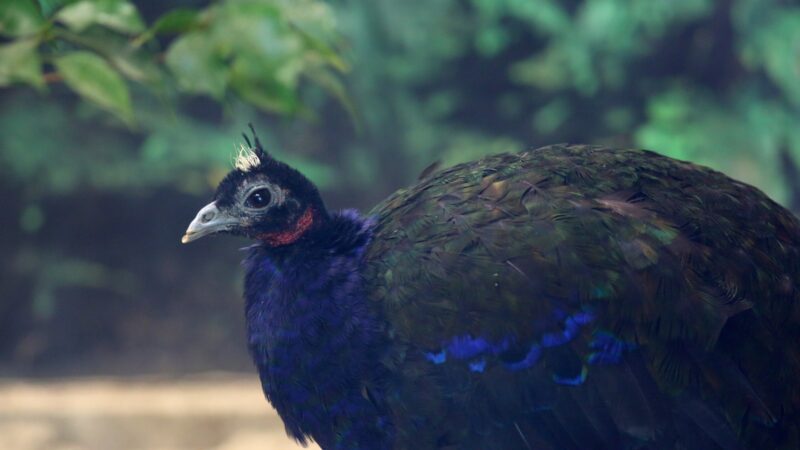
Although they have a large and wide distribution area in Congo and are only categorized as near threatened by the IUCN, this peafowl is rare and elusive. The Congo Peafowl is restricted to the central region of the Congo Basin, a place that is difficult to access.
- Appearance: Large-sized bird with deep blue, violet, and metallic green feathers. Its neck is a bare red color, and it also has a black tail, gray feet and bill, and white feathers on its crown that look like hairs. Females are a chestnut brown color with a metallic green back.
- Lifespan: Unknown
- Height: 60 to 70 centimeters
- Weight: Up to 1.15 kilograms
- Place Of Origin: Congo
- Characteristics: Nocturnal, territorial during the breeding season, and solitary or in small family groups. Not all birds of this species are arboreal.
Green Peacock
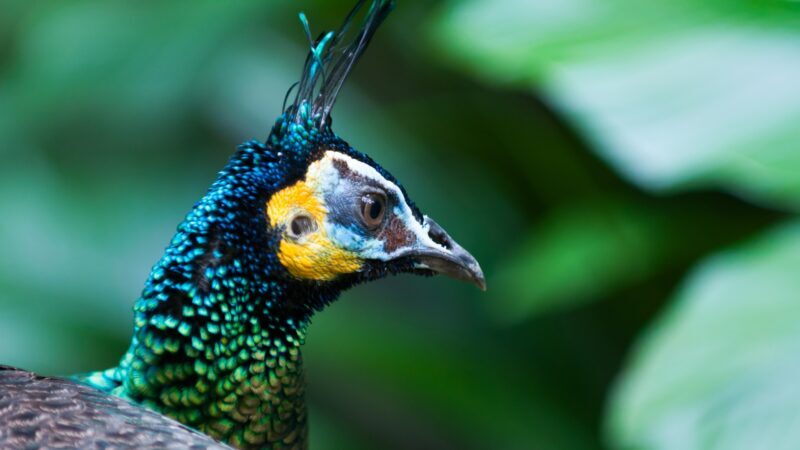
Also known as the Indonesian Peafowl, the Green Peacock is the national bird of Myanmar. It used to be a relatively common bird across Southeast Asia but only a few populations reside in Vietnam and Cambodia. As such, the IUCN recognizes the bird as endangered due to the loss of habitat caused by deforestation and agriculture.
- Appearance: Large-sized bird with a buff or pale vermillion overall plumage, dark wings, glittering green necks, a dark green and shafted crest, long legs, whitish blue facial skin, and long upper-tail coverts decorated with eyespots. Both sexes are similar in appearance, making it difficult to distinguish them apart.
- Lifespan: Up to 20 years
- Height: 1 to 3 meters
- Weight: 1 to 5 kilograms
- Place Of Origin: Myanmar and Burma
- Characteristics: Females can produce 3 to 6 eggs per clutch. Males are known to be solitary and highly territorial. Both sexes spend their time in sedges and tall grasses.
Wild Palawan Peacock
Due to hunting, deforestation, trapping, and egg collecting, the Palawan Peacock Pheasant is categorized as vulnerable. The global population is currently less than 10,000 and is believed to be rapidly declining. The peacock is found in humid and pristine forests and has various vocalizations, including a long, sharp call, hissing, and peeping.
- Appearance: Medium-sized bird characterized by iridescent metallic green and bluish-violet plumage on the dorsal area and an erectile crest. Its ventral region and breast are black in color. It also has erect, iridescent, and light-reflective tail plumes. Females are slightly smaller than males and have earthen plumage.
- Lifespan: Up to 15 years
- Height: 46 to 56 centimeters
- Weight: 322 to 624 grams
- Place Of Origin: Philippines
- Characteristics: Strictly monogamous, highly invertivorous (feeding primarily on invertebrates), and males are solitary except during the mating season, and females thrive in small groups.
Great Argus Pheasant
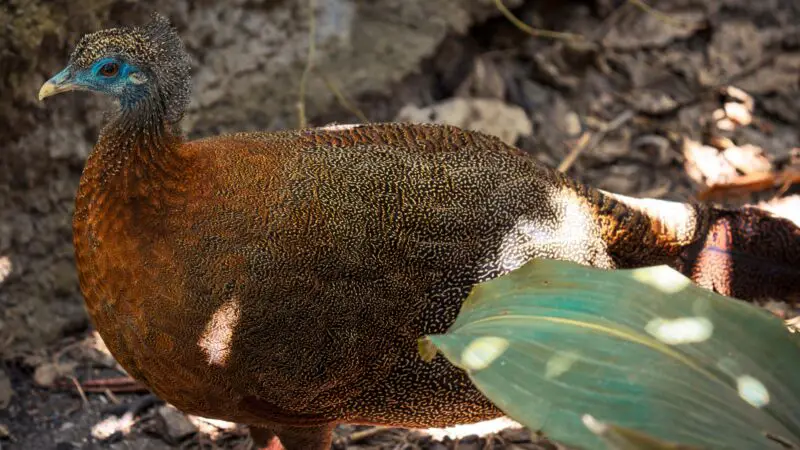
Named after the hundred-eyed giant, Argus, in Greek mythology, the Great Argus Pheasant is known for its spectacular and elaborate breeding display as it performs a mating dance and emits loud calls to attract females. The males of this species are the largest of all other pheasants, with their tails making up nearly three-quarters of their total body length.
- Appearance: Large-sized pheasant with brown plumage, a rufous red upper breast, a blue neck and head, black feathers on the nape and crown, and red legs. Males have long tail feathers and large eyespots on their wing feathers, while females have shorter tails and fewer eyespots.
- Lifespan: Up to 20 years
- Height: 72 to 76 centimeters
- Weight: 1.59 to 1.7 kilograms
- Place Of Origin: Borneo, Sumatra, and the Malay Peninsula
- Characteristics: Sedentary as they do not move long distances, extremely territorial during the breeding season, and solitary except during the mating season. Their loud calls are heard up to 1 kilometer.
Hainan Peacock Pheasant
An extremely rare species of peacock-pheasant, this bird used to be considered a subspecies of the Gray Peacock Pheasant until it was recognized as a distinct species. Due to the declining population, the Hainan Peacock Pheasant is categorized as severely endangered by the IUCN, prompting the need for more conservation efforts.
- Appearance: Large game bird with an overall gray appearance and dark bluish-green dots on its tail and wings. The males have longer tails, a small patch of red skin found around the eyes, and a short bushy crest.
- Lifespan: Unknown
- Height: Unknown (believed to be smaller than the Gray Peacock Pheasant)
- Weight: Unknown
- Place Of Origin: Hainan, China
- Characteristics: This bird is excruciatingly hard to find but is usually detected by the loud, scratchy noises they make as they flip and scuffle through leaves while foraging for food.
Asia Peacock
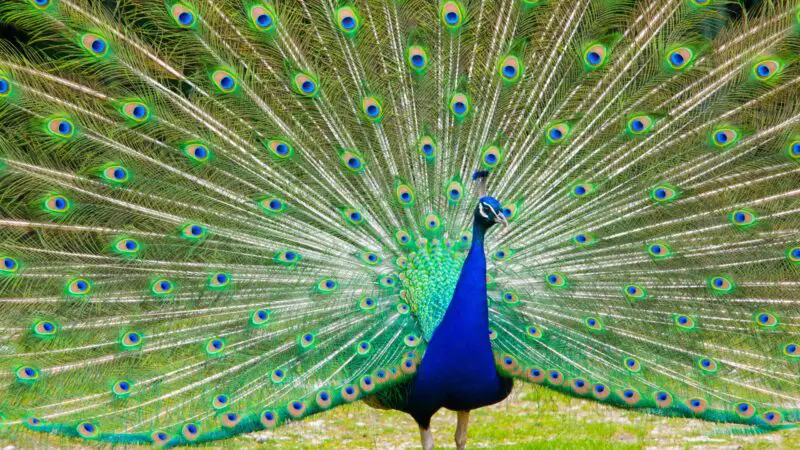
One of the largest flying birds, if the tail length and wingspan are included, the Asia Peacock, otherwise known as the Indian Blue Peafowl, is a widely distributed bird, especially in South Asia. There are about 100,000 birds in the wild, making them quite a nuisance to agriculture and homes since they may damage crops and other plants.
- Appearance: Has three color variations: white-feathered (has completely white feathers on its entire body), pied (has random white feathers in its plumage), and black-winged (has dark feathers with green and blue tips).
- Lifespan: 10 to 23 years (captivity), 10 to 25 years (wild)
- Height: 0.9 to 2.12 meters
- Weight: 2.75 to 6 kilograms
- Place Of Origin: India and Sri Lanka
- Characteristics: Solitary but will form small groups, sedentary, diurnal as it sleeps high up in trees, and territorial during the breeding season. They can hide easily in shady foliage due to their coloring.
Grey Peacock Pheasant
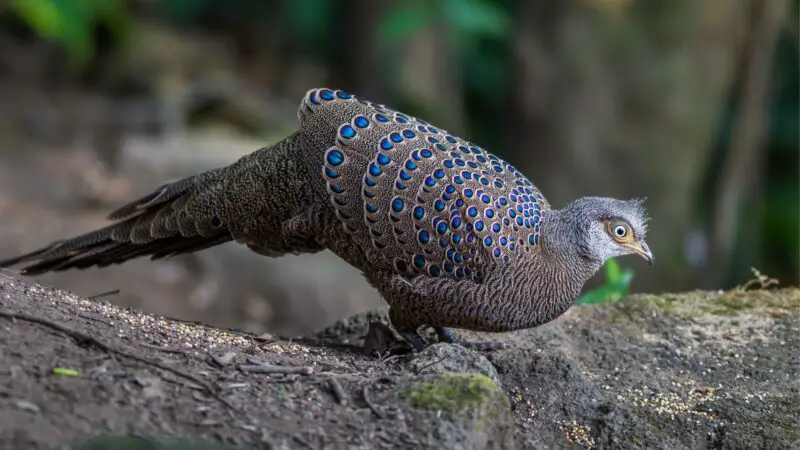
The Grey Peacock Pheasant is a relatively common species compared to other peacock pheasants and is, therefore, categorized as Least Concern by the IUCN. It is a loud-calling ground bird that lives in dense evergreen forests found on hilly terrains. Recent genetic evidence shows that it is more closely related to partridges and peafowl than pheasants.
- Appearance: Large-sized, grayish brown bird with finely-spotted green eyespots, yellow or bare pink facial skin, green and reddish purple oval slices on the tail and wings, broad bushy crest, white throat, and a gray bill, iris, and legs. Females are smaller in size, darker in color, and have fewer ornaments in their bodies.
- Lifespan: Unknown
- Height: 55 to 76 centimeters
- Weight: 500 grams to 1 kilogram
- Place Of Origin: India, Bangladesh, and Mainland Southeast Asia, except for Indonesia and China
- Characteristics: Males perch on a branch to call either in the morning or late afternoon. Females can lay 2 eggs per clutch. They are ghostlike in movement as they seldom jump or fly.
What Is the Rarest Color of Peacock?
The rarest colors of peacocks are white and purple. These are a result of a color mutation of the Asia Peacock, formally known as the Indian Peafowl.
How Many Different Types of Peafowl Are There?
Generally, there are only three known species of peafowl belonging to the Phasianidae family—the Indian Peafowl, the Green Peafowl, and the Congo Peafowl. On the other hand, there are eight known species of peacock pheasants belonging to the same family.
Related Questions
Is There Such a Thing as a Pink Peacock?
Pink-colored peacocks do not exist.
What Is the Difference Between Peafowl and Peacock?
Peafowl refers to both sexes of birds. Strictly, males should be called peacocks while females are called peahens.
What Colour Is a Peacock’s Egg?
Peacock eggs can range from white to gray to pale brown in color.
List of Sources
Distribution of Palawan Peacock Pheasant Polyplectron Napoleonis Morphs
